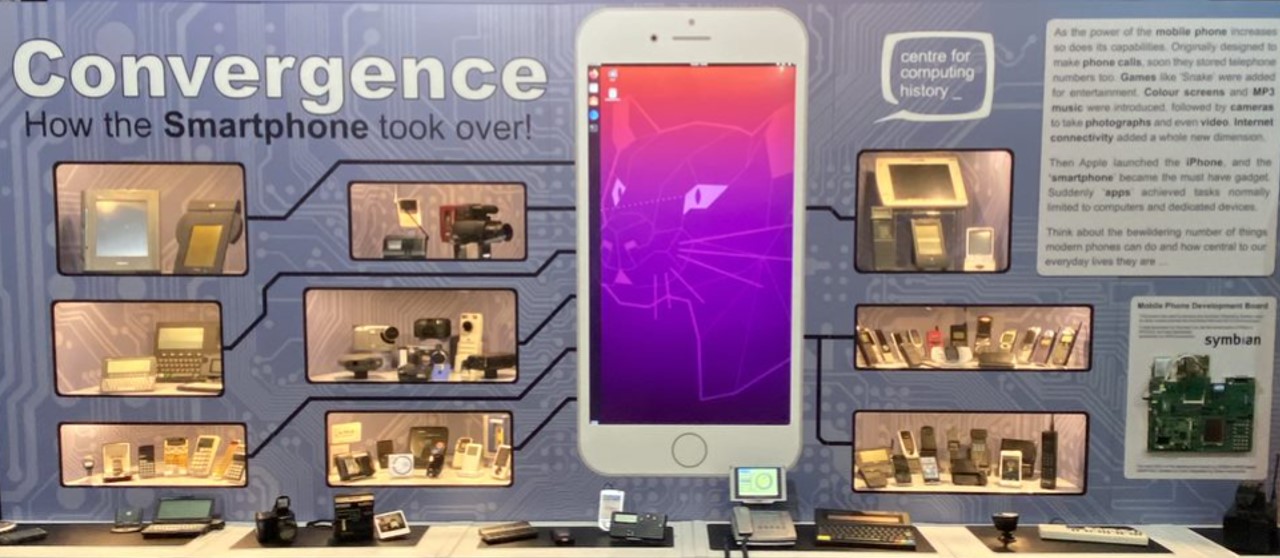Time Travels

The ‘Convergence Wall’ at the Centre for Computing History, in Cambridge, England (photo credit: CCH).
The three ‘Circuits’ of this project are allowing us to approach the formation of computing histories in museums from some very different perspectives.
Our ‘Object Circuit’ (led by Simone Natale) is reflecting upon the material and social dimensions that influence the changing meanings and positions that the objects of computing history might assume. Meanwhile, our ‘Data Circuit’ (led by Petrina Foti) has turned instead to the challenges and questions that confluence around the collecting and curating of ‘data’ as an artefact of computing history.
The ‘Circuit’ I have been leading (with the Centre for Computing History in Cambridge, and the National Science and Media Museum in Bradford) is taking another (perhaps contrasting) perspective.
Rather than looking at the social and cultural nature of digital objects, or the tangible and intangible nature of digital collections, this Circuit has instead been looking to the logical structures within digital narratives themselves. To do this our group has turned to a fundamental concept. Indeed, an elementary and ontological idea that sits at the heart of all conceptions of history, formations of story, and experiences of narration. And that is … time.
Emerging from our work are a number of different ‘dimensions’ of time, and ways in which temporality plays a part in the structuring of computing history in museums.
What is exciting us particularly at this point in our research is the formation a working ‘framework of exhibition time’ – specifically one that helps us to differentiate between a series of individual (what we are calling) ‘latitudes’ relevant to museum exhibitions of computing history.
Our working version of this framework currently looks like this …
A TECHNOLOGICAL latitude – where things are produced on time, developing beyond the museum in the market and society
A NARRATIVAL latitude – where accounts are relayed using time, unfolding in the exhibit’s interpretation
An EXPERIENTIAL latitude – where exhibits are visited in time, elapsing at the venue;
An ORGANISATIONAL latitude – where practitioners are working through time, evolving in the institution;
An ONTOLOGICAL latitude – where life is time, our aging in the world.
It may appear somewhat abstract. However, in practice, as we hold it up as a lens to look at computer history exhibits in our partner museums, this framework is proving enlightening.
It’s helping us to notice (and to articulate) how notions and experiences of time are fundamental to:
- the progression and sequential making of computer technology;
- the recounting and linear articulation of computer history;
- the duration and varied pacing of an exhibition event;
- the maturing practices and operational transformations of the museum; as well as
- the entropy and sensation of existence.
We are finding that the framework not only differentiates these distinct notions and roles of time within computing history exhibits, but also conveys how inextricably bound to each other and inter-connected they always must be.
As our work on ‘time’ in this Circuit progresses we are exploring how this framework of the temporal dimension of computing history in the museum might provide the basis for a series of separate lines of enquiry and points of reflection.
Empowered by this framework we are now motivated and enabled to ask and pursue a new set of questions:
(on technological time) how a computing history exhibit references a developing market and a progressing technological knowledge, and what assumptions that exhibit makes about these market and expert contexts, and how are they temporalized;
(on narratival time) what use of tense the narrative structures of computer history exhibitions observe, what is past, present and future in these narratives, how are they related, and what status is given to each;
(on experiential time) what explicit reference to (and implicit acknowledge of) computing history exhibits make to the duration and pacing of the visit event, whether the exhibit assumes a length of time for the visit experience, and where (and how) it controls that time;
(on organisational time) how the computing history exhibit is a product of an earlier set of practices and a previous stage of knowledge for the museum, where the contrasts might be (in subject knowledge, in curatorial approach, in design treatments) between this display and other displays in the museum; and
(on ontological time) how the computing history exhibit reference the inscribed life of people (as makers and consumers), and the stages, passing and historical period of these lives, and how the exhibit (explicitly or implicitly) acknowledge the life and lifespan of the visitor.
In short, this framework of temporal latitudes is offering us further means to focus and control our discussions around the making of computing history in the museum.
It’s become our guide (or is that a schedule?) for our Circuit, and its on-going travels in time.